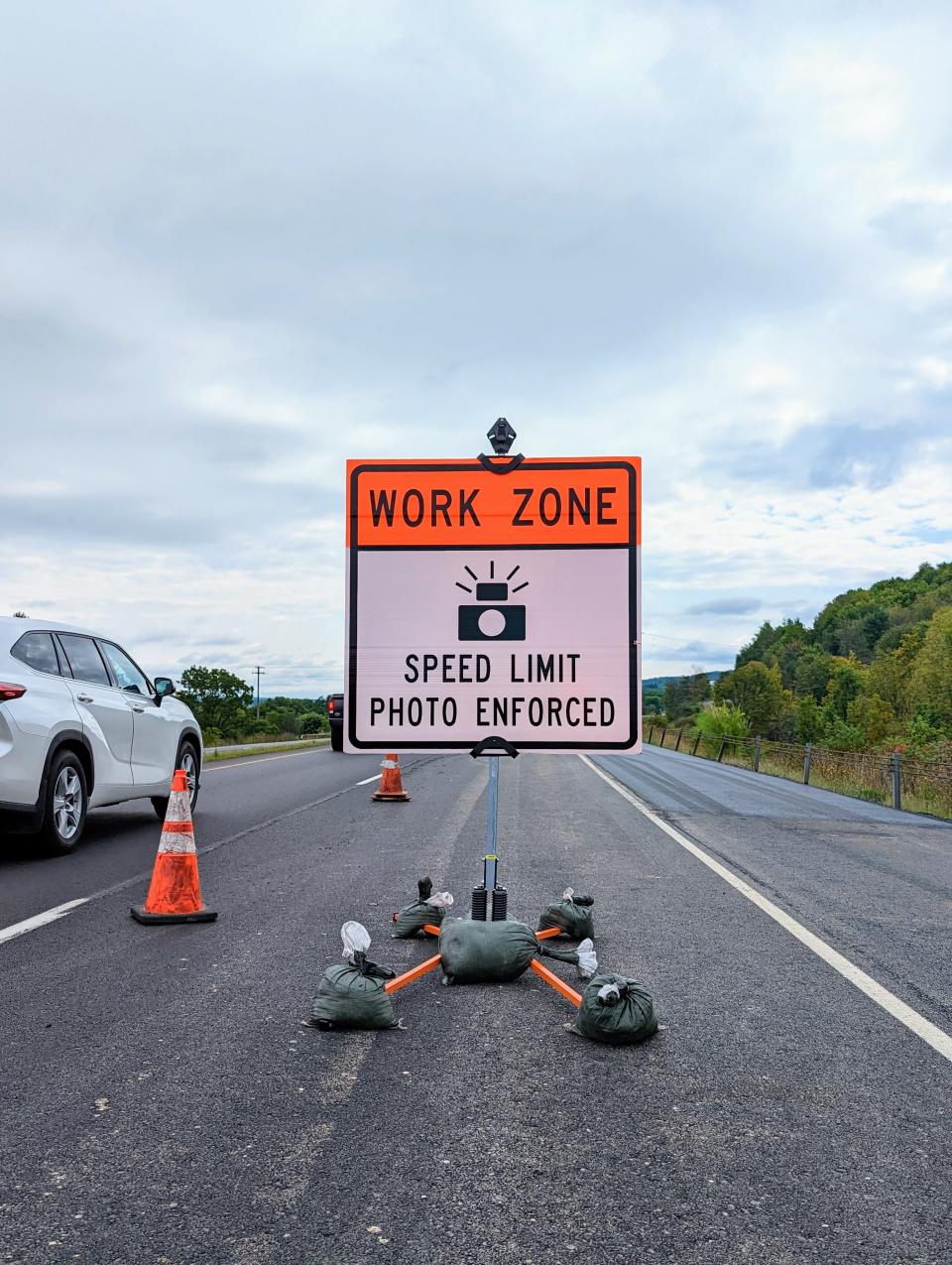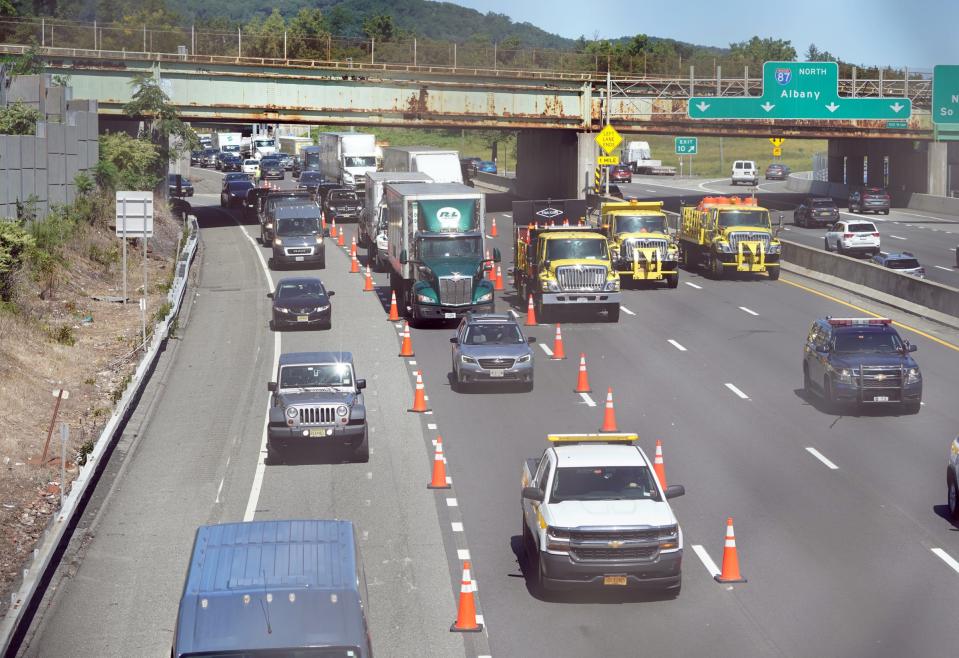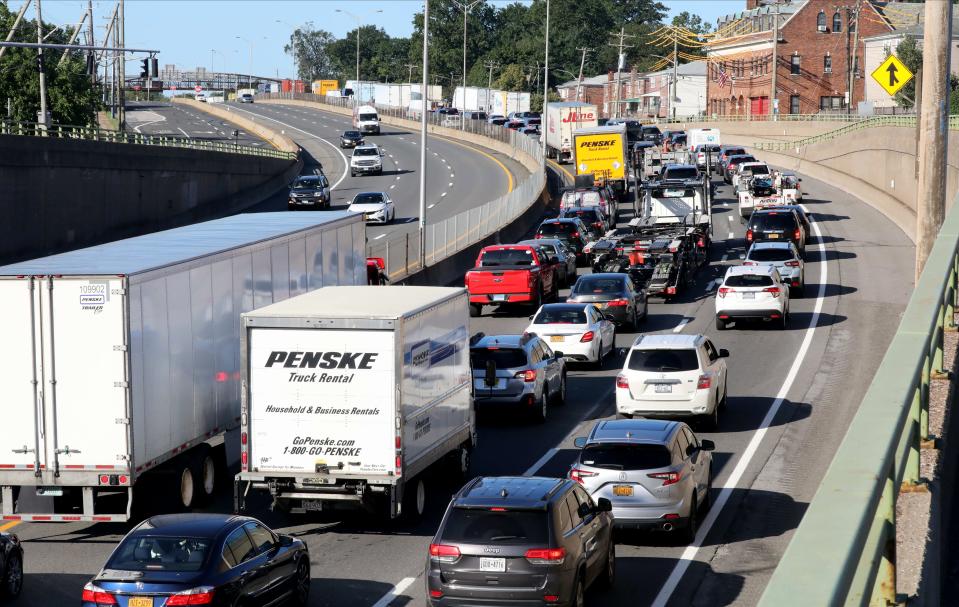NY started automating work zone speed checks six months ago. How many violations so far?
Over 130,000 work zone speeding violations were issued across New York this year through an enforcement program aimed at increasing highway safety.
Gov. Kathy Hochul signed a bill in 2021 to create the five-year Automated Work Zone Speed Enforcement (AWZSE) program. It's managed by the New York State Department of Transportation (NYSDOT) and New York State Thruway Authority (NYSTA).
The program went through a 30-day warning period beginning in April before fully launching in May.
In 2021, 378 work zone intrusions, or incidents where a motor vehicle has entered a portion of roadway that is closed due to construction or maintenance activity, took place on state roads, according to the NYSDOT. More than 50 of the intrusions resulted in injuries to either a highway worker or vehicle occupant.

“New York has zero tolerance for negligent or aggressive behavior that endangers our men and women in labor who work hard every day to keep us moving,” Hochul said. “Work zone speed limits and other restrictions protect highway workers making our roads safer for everyone, and the actions we have taken this year are proving to be effective.”
Here's what to know about the program, what to expect if you receive a violation and how you can pay your fines.
How does the NY program work?
The system, which will be located in construction or maintenance zones in state-controlled access highways and parkways, uses radar to identify any vehicle traveling equal to or faster than the posted speed limit, the state says.
A series of images are then taken as the vehicle approaches and passes the speed safety camera — including two of the back of the vehicle — to track the distance and time of travel.
Additional data collected through the automated speed enforcement units or "mobile units," which are deployed in SUVs, includes time, date, posted speed, vehicle speed, location, lane and direction of travel. License plate information is also collected and used to identify the registered owner of the vehicle.
A state-certified technician then reviews the violation to verify the information before a notice of liability is created and mailed to the registered owner of the vehicle, regardless of who was driving at the time of the violation.

NYSDOT hired five employees to help the agency manage and certify notices of liability, and the NYSTA added two staff members to accommodate the program.
Each enforcement system is run through a daily self-check before capturing violations and the systems are required to be recalibrated and recertified annually.
"The goal of the program is to reduce speeds, improve driver behavior, save worker and traveler lives in work zones, complement existing work zone enforcement by the New York State Police, and promote work zone safety," the state's website says.
Where are the systems located?
The involved work zones have clear signage leading up to the work zone, the state said, and the NYSDOT and NYSTA use a variety of factors — including roadway and work zone characteristics such as facility type, speed limit, temporary traffic control activities and whether traditional in-person enforcement is viable — to determine mobile unit deployment locations.
The final positioning of the units is determined the morning of each deployment.
Thirty units were launched in April and have been moved to different work zones around the state over the last eight months. Most recently, they have been located in Richmond, Nassau, Queens, Suffolk and Kings counties from Dec. 3 to 10.
New rules: NY's DMV wants tougher penalties for high-risk drivers
What happens if you violate a work zone speed limit?
You will face fines of varying amounts if you speed through an enforced work zone.
A $50 fine will be issued for the first violation and $75 for a second violation, if within 18 months of the first. Three or more within 18 months of the first violation will cost you $100 per violation.
The fines are also subject to additional late fees.
Notices are mailed within 14 business days if you're a New York resident and 45 business days if you live out of state.
You can contest the violation by logging into the program violation processing website and submitting documentation to prove the case may fall under a set of "allowable defenses" under the legislation — for example, if vehicle was leased or rented to someone other than the owner at the time of the violation, or if the vehicle or license plate number had been reported stolen before the violation occurred.
Violations can be contested within 30 days of when you receive the notice of liability.
Failure to pay the fines may result in a registration hold placed on the vehicle, and drivers will not be able to renew their registrations without paying the fines. No points are assessed against a driver's license for violations and nothing is sent to individuals' insurance companies.

How the violation numbers break down statewide
Through Nov. 22, 133,640 notices of liability were issued across 20 sites operated by the NYSDOT and 10 located on the Thruway.
Both entities encountered motorists driving at speeds greater than 100 miles per hour through monitored work zones.
More than 7,500, or 9%, of NYSDOT speed violations recorded and more than 1,500, or 4%, of all Thruway speed violations recorded were repeat offenders.
Here's how the numbers break down per region:
Long Island: 41,709
Rochester/Finger Lakes: 32,578
New York City: 12,330
Albany/Capital Region: 4,616
Binghamton/Southern Tier: 1,200
Syracuse/Central New York: 1,140
Poughkeepsie/Hudson Valley: 1,016
Buffalo/Western New York: 849
Hornell/Western Southern Tier: 211
Watertown/North Country: 113
Utica/Mohawk Valley: 99
Thruway: 37,779
The state did not say how much money has been collected in fines.
On the Thruway, the average speed in work zones with a posted speed limit of 45 miles per hour dropped from 47 miles per hour in May to 43 miles per hour in November.
NY Thruway tolls: How much more will you pay from Rochester to other NY cities in 2024?
How do I pay my fines?
Log into the violation processing website and enter your citation and pin number to access your notice, view images and video and determine your options for payment.
The payment options are as follows:
Online: nysworkzone.photonotice.com
Phone: 1-833-268-8120
Mail: P.O. Box 8418 Philadelphia, PA 19101
Make your check or money order payable to "NYS Work Zone Speed Enforcement Program" and be sure to include your notice number, license plate number and state of registration.
The online and phone options have $3.75 convenience fees.
Where is the money going?
The fines will cover expenditures related to the program, according to the state, and 60% of the funds collected will supplement work zone safety projects, as required by law.
Emily Barnes is the New York State Team consumer advocate reporter for the USA TODAY Network. Contact Barnes at ebarnes@gannett.com or on Twitter @byemilybarnes.
This article originally appeared on Rochester Democrat and Chronicle: NY's automated work zone speeding program: Is it working?

